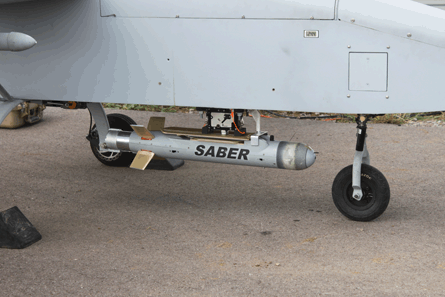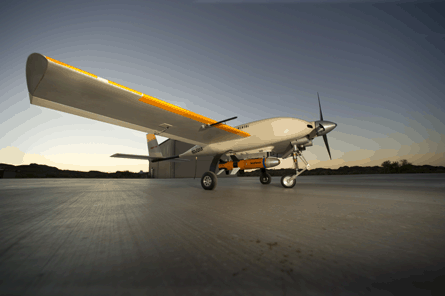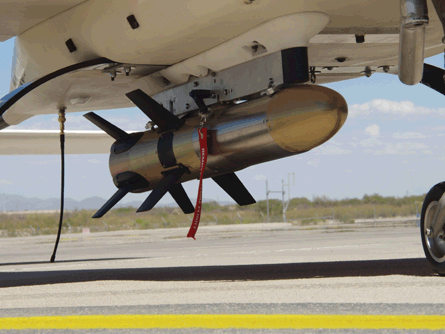No aircraft flies more hours above Afghanistan or Iraq than AAI's unheralded RQ-7B Shadow. Nor does any aircraft have the opportunity to cover more ground or spot more potential targets than the acknowledged "workhorse" unmanned aircraft system (UAS) flown in combat by the US Army and Marine Corps.
But the Shadow is not armed and, until recently, lacked the ability to designate targets for laser-guided weapons. In the best of circumstances, the RQ-7 operator could fix a target visually, and direct other weapon systems - for example, artillery, helicopters or larger UASs - to its location.
The curious absence of this capability after more than a decade of combat operations is now, finally, close to being corrected.
Just as a new wave of guided munitions in miniature scale arrives, the last in a series of operational and policy barriers blocking the weaponisation of UAVs in classes below the General Atomics Aeronautical Systems (GA-ASI) MQ-1 Predator have been overcome.
|
|---|
© RaytheonSABER was unveiled at Farnborough |
After waiting so long for the capability, the military has made clear its intent to arm UASs in classes even smaller than the Shadow.
Industry officials are already discussing options for weaponising the Boeing/Insitu Integrator UAS. Meanwhile, Special Operations plans to rapidly select and field a new kind of hand-launched UAS that is effectively a flying hand grenade.
Few areas of modern combat are debated as much as attacks on humans by "killer drones", but the incidents recorded so far represent only a fraction of possible future attacks.
Within a matter of a few years, the US military aims to increase the number of weaponised unmanned systems from a few hundred to several thousand, allowing the most forward-based troops access to an armed airborne support platform.
That idea has challenged operations planners and even threatened certain interpretations of international non-proliferation treaties. But US military policy is to transform as many tactical surveillance systems into combat systems, and vice versa, as possible, and the small UAS types that log the most flight-hours in combat were difficult to ignore.
The munitions industry took note. Alliant Techsystems (ATK), MBDA and Raytheon have unveiled new products in anticipation of a requirement to arm the RQ-7 and smaller UASs. And the nascent interest has also given hope to some UAS makers seeking to challenge established rivals by preparing their vehicles early for a weaponised future. They were not gambling in the dark. After rushing to install Lockheed Martin AGM-114 Hellfires on RQ-1 Predators by 2002, US military officials moved slowly to integrate weapons on similar UASs. In part, munitions technology had not quite matured to be effective on such small weapons.
Although until recently the smallest air-to-ground missile in the arsenal, the 49kg (109lb) AGM-114 still outweighs by roughly 10kg the maximum payload capacity of the RQ-7B - and only then if the laser designator is removed and rendering the weapon blind.
As early as 2004, the army and navy experimented with adapting precision-guided artillery munitions for the UAS role, but there remained a lack of munitions designed specifically for the RQ-7 size and below.
In April 2010, the army's Aviation and Missile Command released a request for information seeking options for a new class of precision guided weapons weighing less than 11.3kg. These would be small enough to accommodate on the RQ-7, along with the vehicle's optical sensor and a laser designator.
 |
|---|
© RaytheonSABER weapon with ITT Wasp rack on Tigershark UAS |
Within four months, MBDA had unveiled the small air bomb extended range (SABER) at the Farnborough air show. Designed as a family of small guided bombs measuring between 4.54kg and 13.6kg, SABER was the first known responses to the army's call for an all-new weapon to equip the Shadow.
A month later, in August, Raytheon revealed the Small Tactical Munition. The 10cm-diameter, 61cm-long weapon weighs only 5.9kg, but is guided with a GPS/inertial navigation system and a semi-active laser.
ATK also plans to compete in the same market, but with an even smaller munition. In April, it revealed the existence of the 1.81kg Hatchet, which is designed with two sets of three fins for steering and a terminal guidance system. It has displayed an operational scenario showing multiple Hatchets dropping on a mobile surface-to-air missile launcher.
Almost as suddenly as the weapons appeared, the military's interest began changing. The army decided to defer to the Marine Corps on weaponising the RQ-7 fleet. Last December, the Marine Corps announced plans to field a weapon within 12 months of contract award. For the Marines, weaponising the Shadow was a logical next step. Internal studies had shown that scores of targets spotted by roving RQ-7 patrols were not acted upon. In many cases, a weaponised platform could not be summoned in time to attack the target before it moved to disappeared.
Despite an "urgent-needs statement" from Marine commanders in Afghanistan, however, activity in the small munitions sector appeared to halt through the first half of this year. The expected request for proposals from the Marine Corps was never released.
Multiple sources say the weaponisation programme for the RQ-7 fleet was delayed by internal dispute over treaty compliance.
The MQ-1 Predator has been armed since at least 2002 with no policy objections. However, as a usually rail-launched UAS, an armed RQ-7 was considered by some within the US government to be in violation of the Intermediate-Range Nuclear Forces Treaty.
That policy dispute was only cleared up during the last week of July, according to multiple sources. Industry officials expect the Marines to soon launch a competition to supply weapons for the RQ-7. The next step logical step would be to introduce the same capability on the Integrator UAS, as it enters service with the Marine Crops under the small tactical UAS (STUAS)/Tier II programme.
 |
|---|
© RaytheonRaytheon has unveiled new products in anticipation of a requirement to arm the RQ-7 and smaller UASs |
Arming the Integrator may represent the size limit for adding an effective weapon to the payload of a small UAS. After adding a camera and a laser designator, the class of UAS smaller than the Integrator lack any spare room to carry a munition even the size of a hand grenade.
To weaponise the man-packable class of UAS, which includes the near-ubiquitous AeroVironment RQ-11 Raven, it is necessary to develop a new kind of aircraft in which the vehicle itself becomes a flying weapon.
AeroVironment, Textron and Innovative Automation Technologies have been picked to compete for a US Air Force contract to make such a weapon.
The lethal miniature aerial munitions system (LMAMS) could be deployed by the end of next year for special operations forces. Programme documents states that its objective is to "deliver incapacitating effects" on people and light vehicles.
LMAMS is perhaps the ultimate expression of a weaponised UAS. It moves the capability of an armed airborne support platform to small units and even individual forces. The munition is launched by hand. Its optical sensor allows the controller on the ground to see the target - a sniper, perhaps. The controller then steers the vehicle directly into the target.
Special operations units have requested such a system for more than two years, and LMAMS will likely be delivered ahead of even the first weaponised RQ-7. Given the nature of special operations, the LMAMS programme will be much smaller. Budget documents show the air force has allocated only about $10 million for procurement LMAMS systems through the next five years. Deliveries are likely to begin after LMAMS completes a test and evaluation phase in the second quarter of the financial year 2013.
Source: Flight International




















